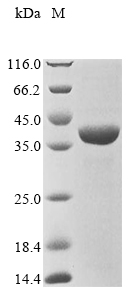Recombinant Staphylococcus epidermidis Shikimate dehydrogenase (NADP(+)) (aroE) is produced in an E. coli expression system and corresponds to the full-length protein, spanning amino acids 1-269. The protein includes an N-terminal 10xHis-tag and a C-terminal Myc-tag, which help with purification and detection. SDS-PAGE analysis shows the protein achieves greater than 90% purity, making it well-suited for various research applications in protein interactions and enzymatic studies.
Shikimate dehydrogenase (NADP(+)) appears to play a critical role in the shikimate pathway—a key metabolic route for aromatic compound biosynthesis. This enzyme is involved in reducing 3-dehydroshikimate to shikimate, which represents an essential step in aromatic amino acid production. Studying this enzyme may provide valuable insights into bacterial biosynthesis pathways and could inform antimicrobial target research.
Potential Applications
Note: The applications listed below are based on what we know about this protein's biological functions, published research, and experience from experts in the field. However, we haven't fully tested all of these applications ourselves yet. We'd recommend running some preliminary tests first to make sure they work for your specific research goals.
Staphylococcus epidermidis Shikimate dehydrogenase (aroE) is a bacterial metabolic enzyme that requires precise folding, proper NADP(+) binding site formation, and specific tertiary structure for its functional activity in the shikimate pathway. The E. coli expression system is homologous to this bacterial protein, which significantly increases the probability of correct folding and functionality. The dual N-terminal 10xHis-tag and C-terminal Myc-tag are relatively small compared to the full-length protein (269 aa, ∼29 kDa) and may cause minimal steric interference. While the full-length protein contains all functional domains, the probability of correct folding with functional enzymatic activity requires experimental validation of substrate binding and catalytic activity.
1. Biochemical Characterization of Shikimate Pathway Enzymes
This application carries a moderate risk without functional validation. Shikimate dehydrogenase activity requires precise active site formation and proper cofactor binding. If correctly folded and active (verified through enzymatic assays), the protein is highly suitable for kinetic studies (Km, Vmax). If misfolded/inactive (unverified), kinetic measurements will yield biologically meaningless results.
2. Antibody Development and Immunoassay Applications
This application is highly suitable as antibody development relies on antigenic sequence recognition rather than functional enzymatic activity. The full-length protein provides comprehensive epitope coverage for generating aroE-specific antibodies. The high purity (>90%) ensures minimal contamination-related issues during immunization.
3. Protein-Protein Interaction Studies
This application requires proper folding validation. Metabolic enzyme interactions require native conformation. If correctly folded (verified), the protein may identify physiological interaction partners; if misfolded/unverified, there is a risk of non-specific binding or tag-mediated artefacts.
4. Comparative Enzymology and Evolutionary Studies
Meaningful comparative studies require native enzyme conformation and functional activity. If correctly folded and active (verified), the protein enables valid evolutionary comparisons; if misfolded/inactive (unverified), comparative analyses would yield misleading insights.
5. Drug Target Validation and Screening Assays
This application carries a significant risk without functional validation. Inhibitor screening requires native enzyme conformation and catalytic activity. If correctly folded and active (verified), the protein is suitable for screening; if misfolded/inactive (unverified), screening results will be unreliable for drug discovery.
Final Recommendation & Action Plan
The E. coli-expressed aroE with dual tags has a high probability of correct folding and functionality due to the homologous expression system. Begin with enzymatic activity validation using standard shikimate dehydrogenase assays (NADP(+) reduction measurements with shikimate substrate) to confirm functionality before considering applications requiring bioactivity. Applications 1, 3, 4, and 5 all require this functional validation. Application 2 (antibody development) can proceed immediately. The small size of the tags relative to the protein minimizes interference concerns. For reliable aroE research, validate specific activity and kinetic parameters before proceeding with functional applications.






